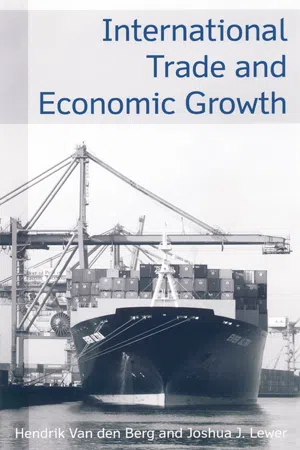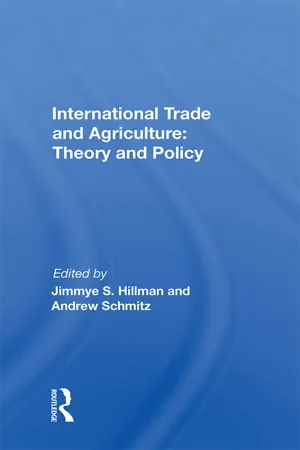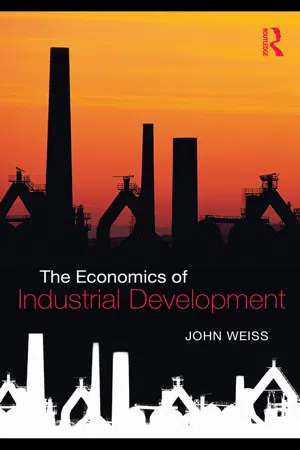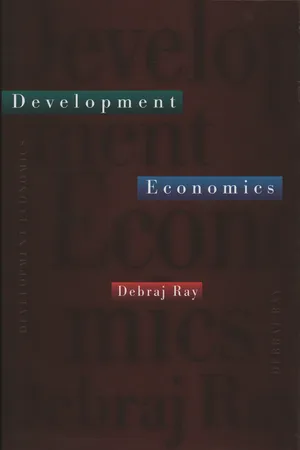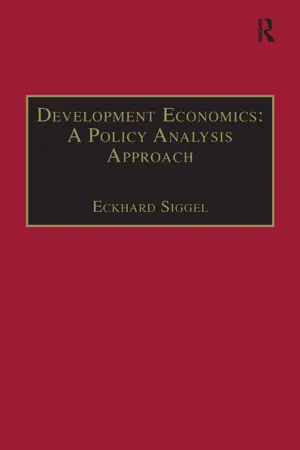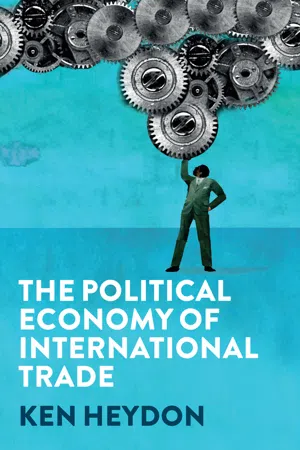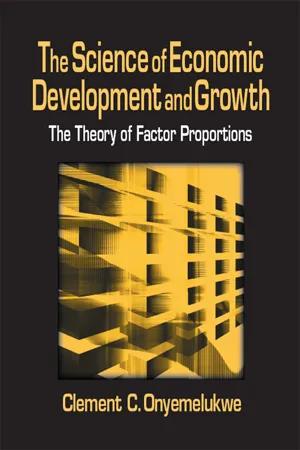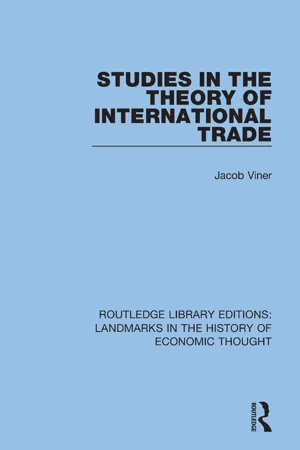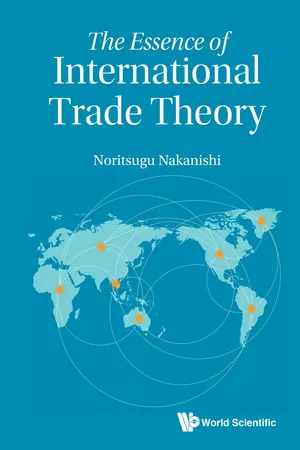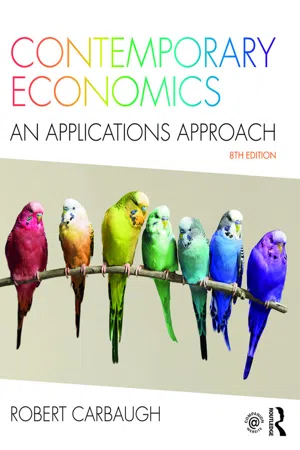Economics
Gains From Trade
Gains from trade refer to the benefits that arise when countries, individuals, or businesses specialize in producing goods and services in which they have a comparative advantage and then trade with others. By doing so, both parties can obtain a greater quantity and variety of goods and services than they could produce on their own, leading to overall economic welfare and efficiency.
Written by Perlego with AI-assistance
Related key terms
Related key terms
1 of 4
Related key terms
1 of 3
10 Key excerpts on "Gains From Trade"
- eBook - ePub
- Hendrik Van den Berg, Joshua J Lewer(Authors)
- 2015(Publication Date)
- Routledge(Publisher)
Chapter One The Welfare Gains From TradeThe proposition that freedom of trade is on the whole economically more beneficial than protection is one of the most fundamental propositions economic theory has to offer for the guidance of economic policy.(Harry Johnson)6Economists have made their case for free trade in two ways. First, they have developed logical models to prove international trade increases human welfare. These models have also provided useful insights into why international trade increases human welfare. Second, economists have used their models to estimate the welfare gains from reducing or eliminating barriers to trade. Since theoretical models are not easy to summarize into a short sound bite, the news media have often presented economists’ numerical estimates of the Gains From Trade as economists’ main contribution to the debate about trade. Economists themselves often use estimates of the Gains From Trade to support their more abstract arguments for free trade.When it comes to the estimates of the Gains From Trade, economists are actually quite vulnerable. For one thing, in going from the basic logic of comparative advantage to specific estimates of the gains from free trade, economists are forced to make specific assumptions about the shapes of the curves, the elasticities of demand and supply, and the distribution of the gains and losses across economic sectors. Different economists make different assumptions and thus come up with different estimates. The differences between the estimates often undermine the credibility of economists. More damaging to their case for free trade, however, is the fact that economists’ estimates of the Gains From Trade are usually very small. Objective observers cannot help but ask whether the inevitable controversy surrounding shifts in trade policy are worth all the fuss.This chapter examines how economists have estimated the Gains From Trade. Since most of the popular estimates of the Gains From Trade have been based on the strict logic of the equally popular static models of international trade, the chapter begins by reviewing these models and how estimates are derived from them. A careful examination of the estimates makes it clear that many potential Gains From Trade have been missed by the most popular estimates of the Gains From Trade. It becomes obvious that the estimated Gains From Trade have been small because the models used to guide the estimates do not capture all of the Gains From Trade. The next section begins our reexamination of economists’ models of international trade and how those models are used to estimate the welfare effects of international trade. - Jimmye S. Hillman(Author)
- 2019(Publication Date)
- Routledge(Publisher)
Part 2 Gains From Trade: Theory ReexaminedPassage contains an image
4 The Gains from International Trade
Robert G. Chambers John M. Letiche Andrew SchmitzEven though classical, neoclassical, and every school of postclassical economists have long emphasized that nations can gain from an expanding volume of world trade, in the last years of the 1970s many sectors of national economies—including agriculture—were once again becoming more protectionist. In view of that fact, this chapter will examine the arguments supporting the free-trade doctrine in the context of major theoretical developments in the Gains From Trade literature. The classical writings on the issue are voluminous. They have been excellently appraised, however, making it possible to present the essential foundations with comprehensive brevity.1 Most of the focus will be on the normative aspects of neoclassical trade theory, and only the standard results will be considered. The many paradoxes in modern trade theory are discussed in a companion chapter.2The Early Writings
The classical theory of international trade was formulated primarily to provide guidance on important questions of national policy. It originated in Britain where a major issue revolved around the potential gains to England from free trade, as well as the distribution of Gains From Trade between England and the rest of the world. The classical economists utilized three methods in dealing with the question of the Gains From Trade: (1) the doctrine of comparative costs; (2) the increase in income as a criterion of gain; and (3) the terms of trade as an index of the Gains From Trade and its distribution.The free-trade doctrine, as presented by Adam Smith, was based on the apparent advantage to a country of importing, in exchange for domestic products, those goods which either could not be produced at home or could be produced only at costs absolutely greater than those at which they could be produced abroad. Accordingly, the producer of exportables had to have an absolute advantage, and this advantage was generally measured in terms of the labor costs of production. Under free trade, all products entering international commerce would be produced in those countries where the real costs were lowest, and from this doctrine Adam Smith drew laissez-faire conclusions. As he wrote over 200 years ago:- eBook - ePub
- John Weiss(Author)
- 2010(Publication Date)
- Routledge(Publisher)
trade costs ).The basis for the potential gains from international trade is specialisation in the production of goods which a country can produce relatively cheaply, that is specialisation along the lines of comparative advantage . Since the comparison is between costs of goods within one country, there must always be something in which that country has a comparative advantage, in that a good is cheap relative to everything else that the country can produce. A majority of the goods that are sold on world markets are a form of manufactured product; hence, how far countries can take advantage of the potential Gains From Trade will have a large impact on their manufacturing sectors.Gains From Trade
Drawing on international trade theory, many have argued that unlike the arguments in Chapter 2 , it is not meaningful to distinguish between broad sectors, like manufacturing or agriculture. In this view, it is far more important to differentiate between activities that produce goods that can be bought and sold on the world market (tradable sectors ) and those that focus exclusively on the domestic market (non-tradable sectors ).1 In addition, within tradables, given the vast range of possible products, there will be only a limited number in which an economy has a comparative advantage.This reasoning is associated with Neoclassical or market-based views of development that stress the importance of specialising on the basis of an economy’s comparative advantage. Hence, it is not manufacturing per se that is important, but within manufacturing the goods that a country can produce relatively efficiently and thus export successfully to the rest of the world. There are different explanations for comparative advantage differences between countries corresponding to different theories of trade. Cost differences can arise though differential access to technology (Ricardian models), different resource endowments (Heckscher-Ohlin models) or increasing returns to scale (New Trade Theory - eBook - ePub
- Debraj Ray(Author)
- 1998(Publication Date)
- Princeton University Press(Publisher)
multilateral policies followed by groups of countries. We take up each of these in turn. This chapter considers unilateral trade policies.17.1. Gains From Trade?
17.1.1. Overall gains and distributive effects
The classical gains-from-trade argument
A natural way to think about international trade is that it permits an expansion of the production possibility set. In the Ricardian and Heckscher-Ohlin models, we think of one good as being transformed into another in one of two ways. The transformation may be domestic , that is, inputs are taken away from one good and applied to the production of another (this gave us the autarkic production possibility frontier). Alternatively, the transformation may be international: one good is exported in exchange for the import of another. Thus trade may be thought of as a way to extend production possibilities. With trade in different commodities that are not locally produced, such as Spanish cava or Havana cheroots, we can also think in terms of expansion of production possibilities: new commodities can now be “produced” by the trading countries.All of our discussions so far boil down to a single maxim: whenever the rate at which one commodity can be domestically transformed to another differs domestically and internationally, there is scope for gainful expansion of production. The domestic rate is captured by the slope of the production possibility frontier; the international rate is just the international relative price.Thus it appears that trade can never be harmful to a country: it permits all that went before and then some. Note well, in addition, that the argument for the Gains From Trade is independent of whether other - Eckhard Siggel(Author)
- 2016(Publication Date)
- Routledge(Publisher)
The importance of trade for economic development is often measured by its share of GDP. While in large countries trade tends to play a relatively minor role, possibly less than ten percent of GDP, small countries depend more strongly on imports and need to export proportionately more. This relationship between the proportion of trade and country size reflects the availability of resources and the size of markets. Large countries are more likely to possess most of the natural resources they require, and their markets are sufficiently large to produce industrial goods benefiting from economies of scale. Small countries, require export markets in order to produce economically at large scale. They are also likely to import many goods at prices that are lower than their own potential costs of production. In the rest of the chapter we shall focus first on the main rationale for trade and the Gains From Trade, and then examine the arguments against free trade. Next, we discuss the instruments and consequences of inward-oriented trade regimes, as well as trade policy reforms and outward orientation.5.1 Comparative Advantage and the Gains From Trade
International trade is known to be beneficial to countries that specialize in activities, in which they have comparative advantage. The principle of comparative advantage, which was first rigorously analyzed by Ricardo, is one of the most fundamental ones in economics. It states that even if a country is less productive in all activities than other countries, it can nevertheless gain from trading with these countries, provided that it specializes in those activities in which it is relatively more productive. The greater relative productivity is measurable as opportunity cost, which poses no conceptual problems as long as we analyze the simple case of two activities, two countries and a single factor of production, as Ricardo did in his famous demonstration of comparative advantage. To recall, let the two goods, food (F) and clothing (C), be produced in both, the Home country (H) and a foreign country (F). We assume for simplicity that only one factor of production, labour, is used and that the following amounts of labour per unit of output (LF and LC ) are required:Home Foreign Food 5 6 Clothing 10 18 The opportunity cost of clothing in terms of food equals the factor input ratio, LC /LF- eBook - ePub
- Ken Heydon(Author)
- 2019(Publication Date)
- Polity(Publisher)
Part I The Gains From Trade: Winners and LosersPassage contains an image
1 The Political Economy of Trade: The Domestic Setting
The legislature, were it possible that its deliberations could be always directed not by the clamorous importunity of partial interests, but by an extensive view of the general good.Adam Smith The Wealth of Nations IV ii 44, 471–2Trade theory, from the classical models to the New Trade Theory, posits that, with qualifications about the distributional effects, liberal trade brings net gains to welfare. Why then is it so hard to achieve? This chapter – after outlining the key theoretical work – will cover the challenge arising from the concentrated costs and dispersed gains of trade liberalisation and the widespread perception that trade is the primary cause of structural disruption and rising income inequality within the advanced economies. Other explanations of rising inequality will be considered. The chapter will also address the role of special interest groups, the collective action problem and the contrasting ways in which the United States and European Union have used governmental arrangements to try to limit the influence of special interests. Policy implications will be drawn.The Political Economy of Trade: The Three Elements
There are three strands to the political economy of trade: trade and trade liberalisation yield net gains in welfare, but the gains are unevenly divided among winners and losers, leading to interest-group pressure among losers to resist market opening. Each of these elements has a strong theoretical1 - eBook - ePub
The Science of Economic Development and Growth: The Theory of Factor Proportions
The Theory of Factor Proportions
- C.C. Onyemelukwe(Author)
- 2016(Publication Date)
- Routledge(Publisher)
It is clear that if the poorer trading partner wishes to move in the direction of equalizing its standard of living (growth potential) with that of the more affluent partner, it cannot achieve this from free trade. Another way to put it is that free trade changes the microstructure of economies but not necessarily in the direction of macroeconomic growth.Samuelson and Nordhaus summarized what they considered as the economic gains for trade as follows: “When trade has opened up, and when each country concentrates on its area of comparative advantage, everyone is better off.” They define “better off” as a situation where “workers in each region obtain a larger quantity of consumer goods for the same amount of work when people specialize in the areas of comparative advantage and trade their own production for goods in which they have relative disadvantage. When borders are opened to international trade, the national income of each and every trading country rises.”3 Seen in the context of the issues raised, it can be seen that the root to economic growth of poor countries does not lie in international trade.Economists have analyzed international trade in terms of a two-factor economy, rather than Ricardo’s one-factor economy, because Ricardo’s model fails to capture the changes trade can make in income distribution. Bowen, Hollander, and Viaene have indicated that “overall, the Ricardian model seems to raise more questions about the sources of comparative advantage than it answers” and that it “provides no guide as to how labor productivity and comparative advantage can be expected to evolve since it gives no explanation of differences in labor productivities across countries.”4 More serious is a point we had made in earlier chapters that labor productivity is not a suitable economic index when countries differ widely in their factor proportions.In what is called the specific factors model, the assumption is that an economy produces two goods and that we can allocate labor supply between the two sectors. Unlike the Ricardian model, this model provides for the existence of factors besides labor, but whereas labor is said to be a mobile factor, the other factors are said to be specific.5 - eBook - ePub
- Jacob Viner(Author)
- 2016(Publication Date)
- Routledge(Publisher)
index of total gain from trade would beOne advantage of a total gain index over a unit gain index would be that it would clearly show that an increase in the total amount of gain from trade was consistent with an unfavorable movement in the index of unit gain from trade if the unfavorable change in the latter was associated with an increase in the volume of trade.17Terms of Trade and the International Division of Gain from Trade.—J. S. Mill seems to have believed that the commodity terms of trade, taken in conjunction with its comparative costs, provided a criterion of the proportions in which the total gain from the trade of a particular country with the outside world was divided between that country and the rest of the world. He did not state clearly how he would determine the proportions in any particular case, given the actual terms of trade and the two limiting sets of cost ratios, but in one illustrative case, where costs of producing cloth and linen were in the ratio of 15:10 in England and of 20:10 in Germany, and where the actual terms of trade were 10 English cloth for 18 German linen, Mill says that “England will gain an advantage of 3 yards on every 15, Germany will save 2 out of every 20.”18 Cournot interprets this passage as postulating that England has a gain of 20 per cent and Germany a gain (or economy) of 10 per cent, although no percentages appear in Mill’s text. He points out, first, as ground for rejecting this mode of measuring the comparative gain from trade of two countries, that if one of the commodities could not be produced in England at any cost the English percentage of gain from trade would be infinite. He proceeds to a further criticism on mathematical grounds, which seems to me both unimportant of itself and irrelevant to Mill’s position unless it can be shown that Mill thought that England and Germany would, in his illustration, divide the Gains From Trade in the proportions of 20 and 10. Cournot says that it would be equally legitimate to hold that England as the result of trade gets 15 yards of linen for 8 1/3 yards of cloth instead of for 10 yards of cloth, a saving of 16 2/3 per cent, while Germany obtains, as the result of trade, 11 1/9 yards of cloth instead of 10 yards of cloth, for 20 yards of linen, a gain of 11 1/9 per cent. Measured this way, the ratio of the English to the German gain is 16 2/3: 11 1/3, instead of 20:10. “Or, les questions de calcul n’admettent pas de telles ambiguités. C’est qu’à vrai dire l’une et l’autre manière de compter sont purement arbitraires.”19 - eBook - ePub
- Noritsugu Nakanishi(Author)
- 2018(Publication Date)
- WSPC(Publisher)
gains-from-trade proposition:Proposition 4.5 (Gains from Free Trade). A country is better-off (not worse-off) under free trade than in autarky.20Proof. Let , , , be the consumption, production, price vectors, and the utility level in autarky, respectively; also, let x, y, p, u be the corresponding variables under free trade. The expenditure function corresponding to U and the GDP function of this country are denoted by E and Y, respectively. Obviously, we have = U( ) and = in autarky, and u = U(x) and px = E(p, u) = Y(p) = py under free trade. Then, we obtain the following relation:By the definitions of Y and E, we have Y(p) − p ≥ 0 and p − E(p, ) ≥ 0. Hence, E(p, u) − E(p, ) ≥ 0. Since E is increasing in the utility index, we obtain u ≥ .The first bracketed term in the right-hand side of Eq. (4.6) is called the production gain (or the specialization gain) and the second is called the consumption gain (or the substitution gain). The trade gain can be decomposed into these two non-negative effects. If the production possibility frontier has a sufficient curvature or if the indifference surface does so, one of the production gain and the consumption gain will become strictly positive. In this case, the trade gain will be strictly positive (i.e., u > ).Figure 4.3 illustrates the Gains From Trade and its decomposition into the production gain and the consumption gain. Curve ab represents the production possibility frontier (PPF) of a country. The autarkic equilibrium is attained at point e at which the PPF and an indifference curve are tangent with each other. The slope of the common tangency line represents the autarkic equilibrium price . Let us consider trade liberalization of the country. Suppose that the world market price p is higher than in autarky as represented by the slope of line ℓ. The production point moves from point e to point y, where the marginal rate of transformation is equal to p. The budget line under free trade is represented by line ℓ; then the consumption point will be point x at which the budget line and an indifference curve u are tangent. Clearly, the household enjoys a higher utility level (i.e., u > ) than at point e - No longer available |Learn more
Contemporary Economics
An Applications Approach
- Robert Carbaugh(Author)
- 2016(Publication Date)
- Routledge(Publisher)
In recent decades, the U.S. economy has become increasingly integrated into the world economy—that is, it has become an open economy. This integration has involved trade in goods and services, financial markets, the labor force, ownership of production facilities, and dependence on imported materials.As a rough measure of the importance of international trade in a nation’s economy, we can look at the nation’s exports plus imports as a percentage of its gross domestic product (GDP). In 2015, the United States exported about 11 percent of its GDP, while imports were about 14 percent of GDP; the U.S. economy’s openness to trade thus equaled 25 percent. The relative importance of international trade in the U.S. economy has increased by about 50 percent during the past century.The United States exports a variety of goods, including grain, chemicals, scientific equipment, machinery, automobiles, computers, and commercial aircraft. It also imports many goods such as steel, oil, automobiles, textiles, shoes, rubber, and foodstuffs such as bananas, tea, and coffee. The United States’ biggest trade partners are Canada, Japan, Mexico, and China. Other leading trading partners include Germany, the United Kingdom, South Korea, Singapore, Belgium, and Luxembourg.The significance of international trade for the U.S. economy is even more apparent when we consider certain products. For example, we would have no chrome bumpers for automobiles if we did not import chromium, no tin cans without imported tin, and fewer personal computers without imported components such as memory chips. Students taking a 9:00 A.M. course in economic principles might doze off if we did not import tea and coffee. Moreover, many of the goods that we purchase from foreigners would be much more expensive if we depended on American production. Table 16.1 provides examples of fruits that the United States imports.The Advantages Of Specialization And Trade
The notion of being self-sufficient may be appealing. You might even desire to live by yourself in an isolated area such as northern Montana or Alaska. However, living on your own would mean you could only consume the goods that you produce. The food that you eat, the clothing that you sew, and the house that you build would be nothing like the goods that you are currently able to buy. You would not be able to obtain many products, such as cell phones, DVD players, medicines, and automobiles. Because of the constraints of self-sufficiency, most people prefer to specialize and trade with others.
Index pages curate the most relevant extracts from our library of academic textbooks. They’ve been created using an in-house natural language model (NLM), each adding context and meaning to key research topics.
Explore more topic indexes
Explore more topic indexes
1 of 6
Explore more topic indexes
1 of 4
